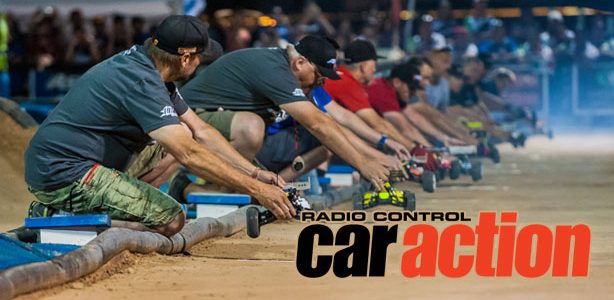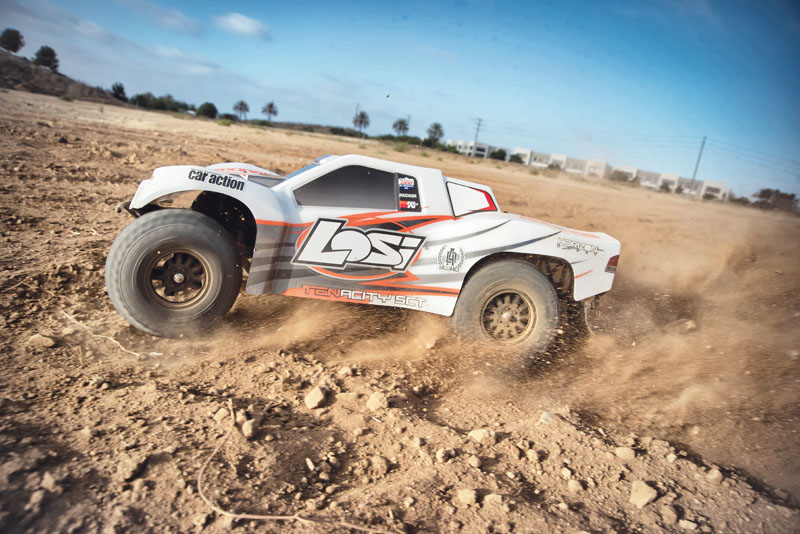If you’ve been following pro RC racing anytime in the last 20 years, you’ve probably heard of Joey Wolters Christensen, aka “Joe Dirt,” a genuine artist with a Bobcat and a shovel (not to mention normal art supplies—more on that later) who has shaped some of RC racing’s most famous (and infamous) tracks. Joey is the go-to guy when promoters and sanctioning bodies need a professional track that can challenge drivers and ensure action-packed racing, and he has been delivering since 1999. We caught up with Joey between shovel sessions to talk about his life in RC.
RC Car Action: How did you discover RC cars? What was your first hobby-quality car?
Joey Christensen: My earliest memory of RC cars was somehow getting a Tamiya Grasshopper. It did not have a radio or any extra parts—it was just the car. I was amazed at how realistic and cool the shocks were. I would roll that car around and make my own car noises and pretend it was a real car! [laughs] Being that there was no radio or any other parts to it, I moved on fairly quickly, as bikes and skateboarding were calling my name! I was an only child. My stepdad, Bear, was my dad since the age of seven. He had no other kids and was one of the nicest and most loving people I had ever met. He owned his own automotive/radiator business and was a hardworking man who never missed a day of work. He bought used motorcycles and BMX bikes and repaired them so that we could all race together. He bought an old motor home so that we could travel to races. He bought a trailer at Lake Havasu and an old boat so that we could enjoy the weekends fishing, skiing, camping, and riding motorcycles in the desert. He bought us an old dune buggy, and I learned how to drive stick at 12 years old, with wooden blocks on the pedals so that I could reach. But after marrying my high-school sweetheart and having two kids by the time I was 19, I moved quickly into family and fatherhood.
Skip forward to 1999. I had been involved in opening surf-, skate-, and snowboard shops in outlet malls up and down the California coast. I set up the stores, hired all of the employees, designed the look, and oversaw the daily operations. After a successful few years, we sold the stores, and I found myself off from work for a while, looking for something fun to do. My dad had a guy that worked for him who was into racing RC cars at the local track in Hemet, California, where I lived. My dad and I went to watch one night, and I was so excited and couldn’t believe how cool the cars were. I wanted one! He said, “Well, the problem is you buy all of the stuff and, a week later, you decide to get out of it and you are stuck with all this stuff!” I was bummed because he had got me all excited and then pulled the plug. [laughs] To my surprise, the very next day he came home from work and had bought all the stuff—a new Losi Double-X NT gas truck and everything that goes with it! He said, “I’ll buy all of the stuff and you drive it!” That sounded like a great deal to me and off we went. It was a great time to be back doing fun guy stuff with my dad.
I eventually took over the Hemet track in 1999, and we hosted the first-ever Dirt Nitro Challenge in 2000. There were 111 entries, and all of the top pros were in attendance. I think Jared Tebo was 12, and Richard Saxton was the top legend in the sport, with his pit man Regan Leblanc. I had built this over-the-top track, and I felt it was going to really highlight what these cars could do. To my surprise and a bit of embarrassment, Richard Saxton felt the jumps were too big and cut them all down! [laughs] Looking back, I was really pushing the envelope and they were just not used to my style yet. I was a great learning experience, and the race has grown into the largest outdoor off-road gas race in the world, with entries reaching more than 1,000. This year will mark the 20th annual Dirt Nitro Challenge, and I am so excited.
Where did the name “The Dirt” come from?
All of my friends from my hometown of Hemet had moved away to the beach cities, and every time they would come visit me, they would refer to Hemet as “The Dirt.” There was nothing but dirt roads and places to race off-road. The road leading into Hemet was called “The Dirt Highway.” So when it came time to design a new logo for the track, I named it “The Dirt” and drew all of my own logos. The Dirt represents my hometown and a lifetime of racing in the dirt. To me, it is the main ingredient in off-road racing, and I put that on my first business cards. [laughs] I still have them!
You’re also an artist. Tell us about that.
I have been an artist since I was a small child. My grandmother had a “how to draw” book, and I drew every picture in that book religiously. I was probably six years old at the time. I would go on to draw and paint my way through school, entering into every art show and art contest, eventually winning an art scholarship. In high school, I painted my junior-year wall and my senior-year wall, and designed our yearbook. I started a window-painting business at 17 and painted signs for the local businesses in town. I was also an avid ceramic enthusiast and was president of the art guild in high school. I would sell my pottery to the other teachers at the school. I ended up buying a ceramic studio from a former teacher right out of high school and set it all up in my garage. In my early 20s, I worked as a set painter/designer at Knott’s Berry Farm as well as set painting at Disney. So when I first had my own track in Hemet, I immediately started to design my own logos and team-driver logos. The idea of having the top drivers at the time putting my sticker on their cars was so cool to me. This was before big contracts, team managers, etc. I decided that I would have my own team—basically, guys that I would give stickers to and hope they would run them on their cars. My sticker team was made up of Adam Drake, Jeremy Kortz, Greg Degani, Jared Tebo, Chad Bradley—I think I’m missing a few—but it was so fun drawing and making the stickers. To this day, “The Drake” logo is one of the most recognized in the RC world! I currently create hand-drawn logos for customers all over the world, from last names to business names. It’s so fun and allows me to be creative on adaily basis.
Does building tracks scratch that artistic itch at all?
Track design is the most creative artistic thing I do, I think. I usually wait to get there and walk the track area to get a feel for the natural ups and downs and, of course, what the client wants—skill levels, etc. I never draw out the jumps beforehand. I might draw out an idea of which way the lanes will go just to show the customer, but that usually changes very quickly. I feel like it is the same as painting or drawing—you create as you go. New ideas come as a section gets made, and they complement each other; eventually you will end up with a track that flows properly. I like that, when I am finished, it looks like a piece of art—a dirt sculpture!
What other types of art do you like to make?
As far as other types of art, I’m really into painting these days. I like acrylic and watercolor. I used to sell paintings on a regular basis to businesses—from coffee shops to banks and hotels. I have been so busy with RC cars over the last 20 years that I am just now getting back into it. I have recently moved to Palm Springs, California, and it is really an art mecca. I love the vibe here, and it is such a creative place. I’m hoping to have enough paintings soon so that my girlfriend and I will have an art booth at the local Thursday-night street fair. That’s the plan.
You’ve built some of RC’s most legendary tracks. Tell us about a few of your favorites.
Wow, let’s see—over 20 years I start to forget! In those 20 years, I have designed and built over 300 tracks—in 25 states as well as seven different countries, including India and China! I’ve been fortunate to be able to put on a good variety of races, including the ROAR Offroad Nationals, the NORCA Nationals, 19 years of Nitro Challenge events at three different venues, three Silver State events, and the Texas Lone Star Challenge for five years, and was able to hold my own event called “The Dirt Nitro Challenge” in Rio de Janeiro, as well as more than 10 other tracks in Brazil, and The Dirt Nitro Challenge in Italy at IBR Padova. I have built tracks for celebrities and NFL athletes. I was asked to build a jump for an RC car segment on the Dave Letterman show, which never came to be, and built a custom home track for the son of Sheldon Adelson, the man who owns the [Las Vegas] Sands Corporation and The Venetian hotel. I was asked to build a track for [hip-hop artist] Tyga and his MTV show. To top it off, myself, Aaron Webb, and The Dirt crew have been recruited three times from different production companies in Hollywood to do an RC car reality show, [which would] follow us around building tracks and putting on races. It’s cool that RC cars are on the TV radar that much!
My favorite track—man, that’s hard to say. I think the first track I built at IBR Padova in Italy was such a cool track and a great learning experience. The track builds in Brazil are really cool too—and the most challenging! From the tools and equipment and to culture, food, and just the overall change in environment, it is a challenge to be on the road for a few months in another country, traveling on planes and buses, and getting picked up by people you don’t know who don’t speak English. [They have] different food and sleep schedules, and they just want you to build the same track they saw on LiveRC from the Nitro Challenge! Oh man, Brazil has been the most fun and the most challenging for sure—some of the most beautiful people in the world, inside and out.
But my favorite has to be the new indoor Silver State. It was so dang cool to see the cars flying through the air on the big hotel marquee as you drive into Vegas! The hotel/casino was full of advertisements, and everyone was so excited to be racing there. You could watch the races from your room or go relax in the pool before your next heat—it was the best! We are so looking forward to teaming up with the South Point Hotel, Casino & Spa for next year’s event. Definitely stay tuned for the dates!
Assuming you’ve already got a level spot and dirt has been delivered, how long does it take to go from zero to race-ready track?
I can build a small track in one day and a large, more detailed track from three days to five days. A track like the Nitro Challenge takes maybe seven [days], as I wear a lot of hats during the build so I am constantly doing multiple things at once as well as building the track. I have to set up a makeshift office inside of the skidsteer—no lie! [laughs]
How has track design changed since you built your first track? What are the most common requests you get for track features?
I feel like, for me, I try to make the tracks bigger with wider lanes. I think that, with 10 to 15 cars on the track at once, the lane width needs to be wider. Other than that, I have the same process for every build: get out there and start creating, and see what I end up with!
I think it was about 13 years ago, at the first DNC in Arizona at The Nitro Pit, I built a huge step-up jump. After the final mains, we actually had a step-up contest that was broadcast on LiveRC; I think you can still look it up. Ever since then, people ask me for the “Joey Jump.” I didn’t get it the first time I heard it, but I get requests for it all of the time. [laughs]
Where do you see RC racing and track design going in the next 10 years?
I have a feeling racing is going to get more fine-tuned, more streamlined into specific channels. A national series, like the one I’m starting in 2019, and maybe a sports TV channel that covers it? I see RC racing becoming more professionally packaged and bundled for a better platform to give it more exposure. I see good things for racing. As far as track design, I see two things: tracks designed for spectators, which will encourage crazy crash-and-burn action, and layouts for club- and big-event races along the same lines as what we have now but a little more fine-tuned I think.
You’re known to get up to some shenanigans after the track is built and the race day is done. Got any favorite stories?
One year during the Nitro Challenge at The Nitro Pit in Arizona, I had bought a really nice pit bike motorcycle to raffle off. I had instructed my crew (my crazy son Curran, Minnesota Tony, Webbslinger, and a few others) NOT to ride the motorcycle before it was raffled off, as I didn’t want anything to happen to it. I had it stored in my room back at the hotel, so it was safe until the Saturday of the raffle. I rent all of the rooms for the crew, and I have my own so I can duck out early if needed so I can be ready for the next day…someone has to be responsible. [laughs] So on Friday night of the event, it happened to be my daughter’s birthday (she was one of the Dirt Girls that year), and we had bought her this giant chocolate cake. We had a small celebration in one of the rooms, and I decide to call it a night and go to my room to get some rest, as I think everyone else will do the same. Not so much. [laughs] After I go to bed, Curran smears a little chocolate-cake frosting across Scott Hughes’s nose—yes the famous “Squirrel” himself—that basically sets off a giant chocolate-cake food fight in one of the rooms. Cake is on the ceiling, walls, carpet, and even in the bedsheets! After the cake fight, the boys decide it sounds like fun to have races in the hotel hallways. One team gets the bellman cart and the other…you guessed it, the motorcycle. Flash-forward to the next morning. I am at the track early, getting ready for the day’s events, and I get a call from the hotel manager. He is furious. He tells me he has kicked me out of all of the rooms I have rented and needs me out immediately…and he is so upset that other guests had complained about motorcycle noise all night. To top it all off, he wanted me to pay for all of the damage that the motorcycle oil had caused in the room. He said there were oil stains and dirt all over the room, on the walls, in the carpet, in the beds—basically everywhere. I was shocked and asked him if I could find out what happened and call him back, which he agreed to. After getting the full story from the crew, I called him back and explained that all of the motorcycle oil was actually chocolate-cake frosting and the dirt was the cake, which really didn’t make it any better [laughs], and that it was my young crew who were celebrating a birthday that got out of hand. He decided to let me stay as long as I cleaned everything spotless immediately. I agreed, the room got cleaned, and the motorcycle got raffled off. It is one of those times I will never forget.
Final question: What’s next for Joey Christensen?
I’ve got 6 paintings to paint for a client and two new potential race venues for The Dirt Nitro Challenge 2019 to visit, a trip back to South Dakota for a track build, a trip to Nice in France for a build to plan, and then I’m off for a few weeks to spend with the family!
Sounds fun—thanks for talking with us!








![RC Car Action - RC Cars & Trucks | This 1/3 scale 125cc V10 Buggy is CRAZY [VIDEO]](https://www.rccaraction.com/wp-content/uploads/2018/05/V10-HP.jpg)


 Stay up to date with the latest information, sign up for our FREE newsletter today.
Stay up to date with the latest information, sign up for our FREE newsletter today.
